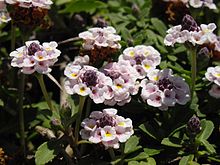Phyla nodiflora
Appearance
| Phyla nodiflora | |
|---|---|

| |
| Scientific classification | |
| Kingdom: | Plantae |
| Clade: | Tracheophytes |
| Clade: | Angiosperms |
| Clade: | Eudicots |
| Clade: | Asterids |
| Order: | Lamiales |
| Family: | Verbenaceae |
| Genus: | Phyla |
| Species: | P. nodiflora
|
| Binomial name | |
| Phyla nodiflora | |
| Synonyms[2] | |
| |
Phyla nodiflora, commonly known as the Turkey Tangle Fogfruit,[3] is a species of flowering plant in the family Verbenaceae. It can be found in the Tropics around the globe.[2] It is often grown as an ornamental plant for ground cover, and is often present in yards or disturbed areas.[citation needed]
Description
The inflorescence consists of a purple centre encircled by small white-to-pink flowers. The flower takes on a match-like look, which is why the plant is sometimes called matchweed. It is similar to the related species Phyla lanceolata, but differs in having much shorter leaves that are often blunt and much more rounded. Both species are common as weeds and in the ornamental environment.[citation needed]
References
- ^ Lansdown, R.V. (2019). "Phyla nodiflora". IUCN Red List of Threatened Species. 2019: e.T164053A67789742. doi:10.2305/IUCN.UK.2019-2.RLTS.T164053A67789742.en. Retrieved 18 November 2021.
- ^ a b "Phyla nodiflora (L.) Greene | Plants of the World Online | Kew Science". Plants of the World Online. Retrieved 2023-07-09.
- ^ "Lady Bird Johnson Wildflower Center - The University of Texas at Austin". www.wildflower.org. Retrieved 2023-07-09.
External links
Wikimedia Commons has media related to Phyla nodiflora.

